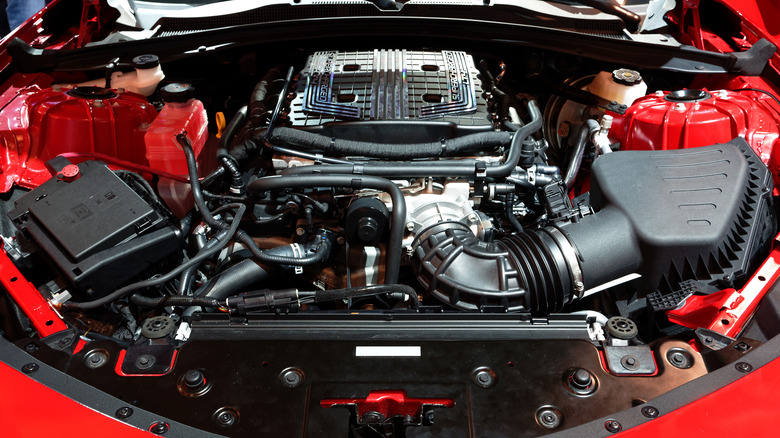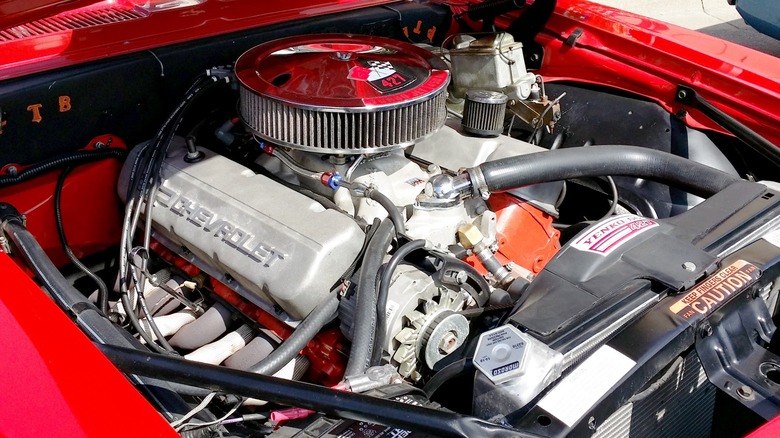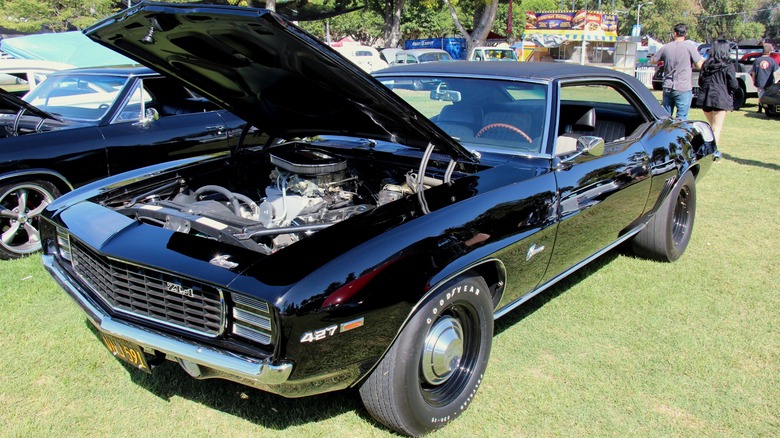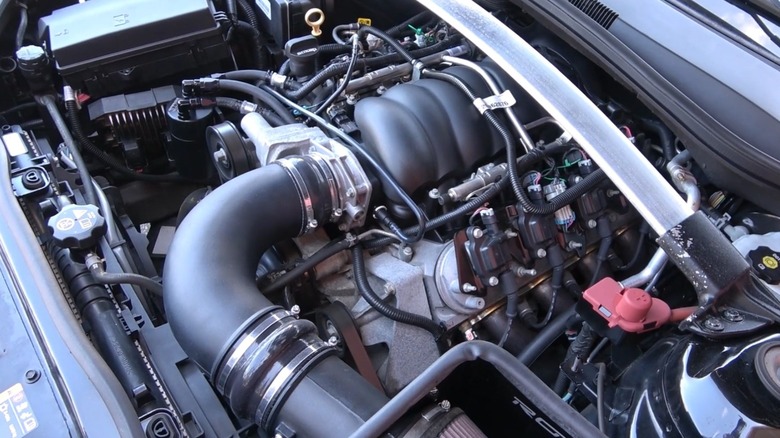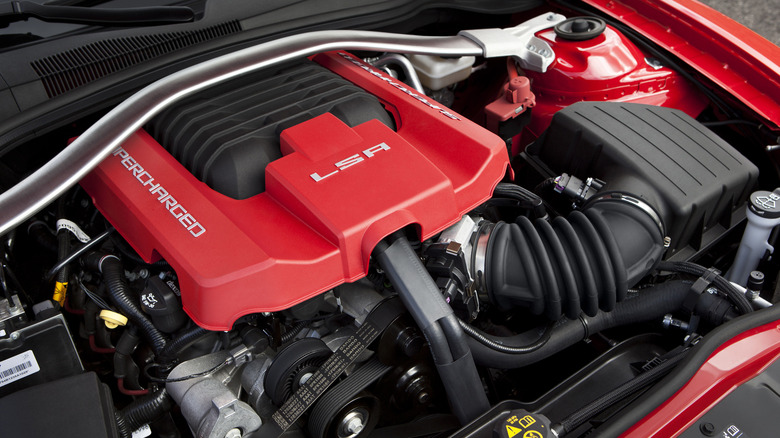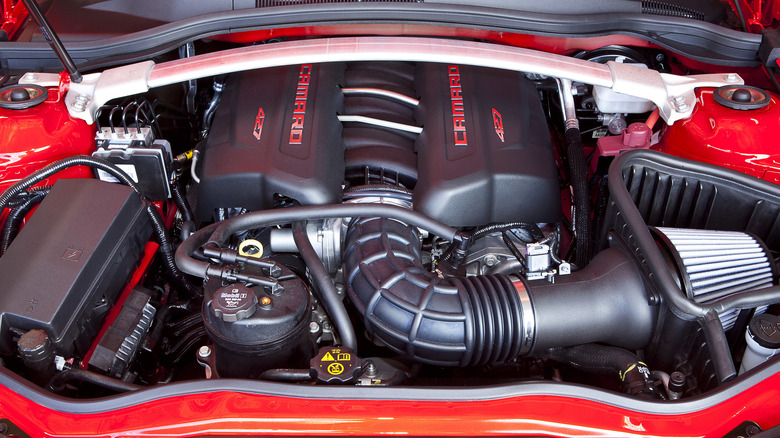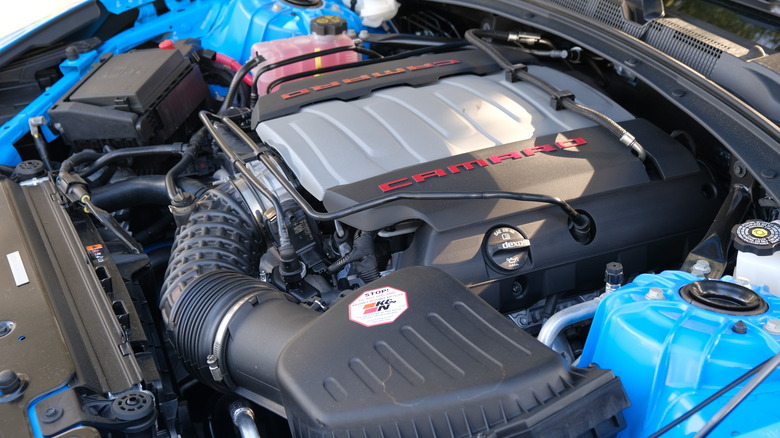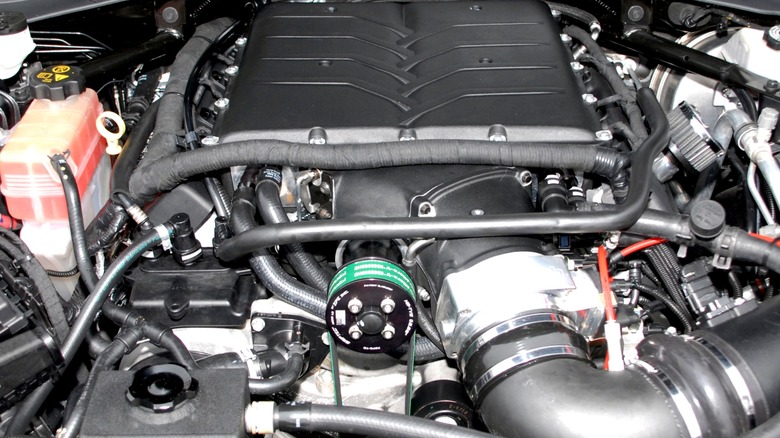The 7 Most Powerful Engines Put In The Chevrolet Camaro
As far as pony cars go, few nameplates have as much cachet as the Chevrolet Camaro. Introduced in 1966 for the 1967 model year, the Camaro was late to the game — Ford and Plymouth had already released the Mustang and Barracuda, respectively, in 1964 — but eventually became a bonafide muscle car competitor, rivaling Mustang through most of the 1970s and 1980s, as well as on its initial return in the 2010s. Unfortunately, as with so many of our beloved high-performance, internal combustion engine-powered cars, Chevrolet has announced that it'll be retiring the Camaro name after 2024, possibly due to poor sales over the past few years.
While the company hasn't said it's abandoning the Camaro name entirely, it has yet to offer any hints as to what the future holds for the storied name. But whether the Camaro and its V8 engines are gone for good or just gone for now, one thing's for certain: No matter what Chevrolet does with the Camaro name in the future, the company can be proud of some of the power plants it's used over the Camaro's six generations and 50-plus years.
From the semi-official ZL1 and L72 V8s in 1969's COPO Camaros to the fire-breathing supercharged LS and LT engines of more recent vintage here's a look back at some of the most powerful engines GM has ever put in the Camaro.
427 L72 V8: 425 hp
The L72 engine was a 4.25-inch stroke and 3.76-inch bore cast-iron V8 that debuted in the 1966 Chevrolet Corvette, where it initially made 450 gross hp. However, a few weeks into production, Chevy dropped its rated power output to 425 hp to keep it under the radar of insurance companies and government officials.
For whatever reason, Chevrolet didn't offer the 427-cubic-inch L72 — also known as the Turbo-Jet — as an option in the Camaro when it debuted in 1967, choosing to go with a 295 hp Turbo-Fire 350 as the most powerful engine option. But that didn't stop Chevrolet dealers like Don Yenko from offering modified 1967 Camaros equipped with the L72. These early Chevrolet-Yenko muscle cars were essentially aftermarket cars, with dealers bringing in finished big-block Camaros and installing the L72 themselves.
This arrangement lasted for a couple of years before Yenko convinced Chevrolet to make the Camaro and L72 combination a semi-official option via a Central Office Production Order (COPO) code in 1969 — following in the footsteps of fellow Chevy dealer Fred Gibb, who'd specced 50 L78-equipped Novas the year before. Dealers and buyers who knew the right code could get a 425 hp L72-equipped Camaro straight from the GM assembly line for an extra $489.75 (just over $4,100 in 2024), with no aftermarket modifications necessary.
Chevrolet built 1,015 L72 engines for the Camaro COPO (including warranty units), indicating that around 1,000 Camaros left the factory with the L72.
[Image by Eric Friedebach via Wikimedia Commons | Cropped and scaled | CC BY 2.0]
427 ZL1: 430 hp
Fred Gibb may have kicked off the COPO Camaro craze in 1968, but it wouldn't be until the following year that he would make his most lasting contribution to Chevrolet lore. In alliance with Chevrolet's Vince Piggins and fellow dealer Dick Harrell, Gibb came up with the now-legendary COPO order number 9560, which involved installing an all-aluminum 427-cubic-inch ZL1 engine into the 1969 Camaro.
The ZL1 was a race-derived version of the 427-cubic-inch L88 big-block engine. It was a 4.25-inch bore and 3.76-inch stroke engine with open-chamber heads and other improvements such as sturdier construction and larger exhaust ports, resulting in a reported 430 hp and 450 lb-ft of torque. However, as with many of its contemporaries, the real horsepower number was much higher, to the tune of around 525 hp.
Gibb ordered 50 ZL1 Camaros to fulfill Stock Eliminator's homologation rules, and other dealers ordered another 19 once word got out. Unfortunately for Gibb and his fellow dealers, ZL1 Camaros proved a tough sell — not surprising, considering the $7,300 retail price (just over $62,000 in 2024). Gibb ended up returning 37 of his cars to Chevrolet, while other dealers went so far as to swap in different engines to try and make their COPO Camaros more sellable. Only 69 ZL1-equipped 1969 COPO Camaros were ever built, making it one of the rarest Camaro models ever.
[Image by Sicnag via Wikimedia Commons | Cropped and scaled | CC BY 2.0]
6.2-liter LS3 V8: 426 hp
The Chevrolet Camaro lasted all the way through the lean years of the 1980s and 1990s, even after rivals like the Plymouth Barracuda and Dodge Challenger fell by the wayside in the mid-1970s. But while the name lived on, those were relatively fallow decades for lovers of horsepower. The 400-plus gross horsepower figures of the COPO Camaros were closer to 350 hp with the SAE net horsepower measurements the industry adopted in the 1970s, but even that was a benchmark most Camaro engines struggled to come close to.
That all changed in 2010, however, when Chevrolet unveiled the resurrected fifth-gen Camaro and its very special 6.2-liter LS3 V8 engine, which was the standard engine for the car's SS trim. Chevy initially quoted power numbers of 420 hp and 408 lb-ft of torque for the LS3, but the final numbers were 426 hp and 420 lb-ft of torque — at least when mated to a manual transmission. Fifth-generation Camaros with an automatic transmission had to settle for a similar but lower-power L99 engine instead, which made 400 hp.
The aluminum LS3 — which is still available as a crate engine from GM — sports a 4.06-inch bore and 3.62-inch stroke, rectangular port heads, and a high-lift hydraulic roller cam, and runs at a 10.7:1 compression ratio. The LS3 was available throughout the fifth-generation Camaro's production run from 2010 to 2015, after which Chevrolet replaced it with the LT1 V8 for the sixth-generation Camaro SS.
6.2-liter supercharged LSA V8: 580 hp
A couple of years after reintroducing the Camaro, Chevrolet opted to bring back the ZL1 moniker last seen — officially, at least — on the limited-to-69 ZL1-powered COPO Camaros from 1969. The fifth-gen Camaro ZL1 debuted in 2012 with a focus on all-around racing performance, whether on the drag strip or a road course.
The ZL1 was quite a feature-packed car at launch, boasting tech such as third-generation Magnetic Ride Control suspension, an all-encompassing traction control system (integrating elements such as launch control and even power steering), a rear differential cooler, and oil coolers. Chevrolet leaned quite heavily into this tech advantage at launch, comparing the Camaro ZL1 favorably to pricier — and less well-equipped — European and domestic rivals such as the Maserati GranTurismo and Ford Shelby GT500. And it paid off, too, with outlets praising the 2012 ZL1's handling on track.
But the star of the show was undoubtedly the new engine under the ZL1's hood. The ZL1 packed a 6.2-liter supercharged LSA V8 engine that made 580 hp and 556 lb-ft of torque, making for most powerful engine installed in a production Camaro yet. The Roots-equipped engine wasn't new to the GM stable, having featured in 2009's Cadillac CTS-V. The Camaro version had some differences, however, such as new exhaust manifolds, a modified cooling system, and electric power steering, giving it a minor 24 hp advantage over the CTS-V's 556 hp.
Chevrolet continued offering the ZL1 and its supercharged LSA V8 for the rest of the fifth-generation Camaro's production run.
7.0-liter LS7 V8: 505 hp
The ZL1 wasn't the only vintage Camaro variant that Chevrolet would reintroduce in the early 2010s. The final two years of the fifth-generation Camaro saw the return of the famed Z/28 brand, last seen in 2002 (as the Z28). But instead of the fourth-generation "Catfish" Camaro's weedy 310 hp, 5.7-liter V8, Chevy went all-out for this generation and crammed a monster 7.0-liter LS7 engine — one of the best LS engines ever — under the hood.
As with the fifth-gen ZL1's supercharged LSA V8, the LS7 wasn't a new motor. The 4.12-inch bore and 4.0-inch stroke LS7 had debuted almost a decade earlier in the 2006 Corvette Z06. It sported notable improvements over previous LS small blocks, like a dry-sump oiling system, titanium connecting rods, new CNC-ported aluminum cylinder heads, and an 11.0:1 compression ratio. The result was 505 hp and 481 lb-ft of torque, a healthy increase compared to the LS3 engine in the Camaro SS.
The 2014 and 2015 Camaro Z/28 wasn't the most powerful fifth-generation Camaro — that honor went to the ZL1 and its 580 hp supercharged LSA — but it was still impressive. The Z/28 was all about handling and track performance thanks to its carbon-ceramic brakes, reduced weight, improved downforce, and Mutlimatic Dynamic Suspension Spool Valve suspension. It wasn't all marketing talk, either: Reviewers raved about the car's handling. Not bad at all, especially for a 3,800-pound car.
Chevrolet built the LS7-powered Camaro Z/28 in 2014 and 2015, before leaving the name and engine behind for the sixth generation.
6.2-liter LT1 V8: 455 hp
The sixth-generation Camaro debuted in 2016 touting changes and improvements across the board, including reduced weight and improved ride quality (at least on the SS model, courtesy of GM's Magnetic Ride Control). GM also moved on from the LS powerplant of the previous generation, opting instead for the Gen 5 6.2-liter LT1 V8 as the engine of choice in the top-end SS trim.
Chevy's then-new LT1 had identical bore and stroke measurements as its predecessor — 4.06 and 3.62 inches, respectively — but was otherwise an almost brand-new engine, with several improvements over the LS3 engine. The most notable difference was the move to direct fuel injection and the introduction of Active Fuel Management, the combination of which helped improve power and fuel efficiency. The LT1 also had variable valve timing as standard, a feature only available on certain LS3 variations such as the L99 engine used in the automatic fifth-gen Camaro. Other changes included all-new cylinder heads, updated exhaust manifolds, and a more durable engine block with eight built-in oil sprayers. The latter helped the LT1 run cooler, allowing a higher compression ratio (11.5:1) and more horsepower.
The result was 455 hp and 455 lb-ft of torque when it debuted in the 2016 Camaro — the most power ever in a Camaro SS. Like its predecessor, the LT1 is still available as a crate engine for engine swaps and car builds.
[Image by Dcmaradiaga via Wikimedia Commons | Cropped and scaled | CC BY-SA 4.0]
6.2-liter supercharged LT4 V8: 650 hp
Chevrolet didn't immediately introduce a Camaro ZL1 for the sixth generation, preferring to have the LT1-powered SS lead the way for its latest take on the Camaro, but that didn't last long. The new sixth-generation Camaro ZL1 debuted a year later in 2017.
Like its predecessor, this ZL1 sported a supercharged Chevy V8, although this time, it would be an LT engine rather than the LS of old — namely, the supercharged 6.2-liter LT4 engine, which had debuted a couple of years prior in the 2015 Corvette Z06. The LT4 made 650 hp and 650 lb-ft of torque in both the Corvette and Camaro ZL1, with the engine's numerous changes over the LT1 — aided by its 1.7-liter Eaton supercharger — contributing to the massive power gain.
The LT4 has the same bore and stroke as the LT1, but the similarities mostly end there. Differences between the two engines include a more aggressive camshaft, larger intake and exhaust valves, new cylinder heads, and an improved fuel delivery system. All of these modifications, including the blower, helped make the supercharged LT4 GM's most powerful production engine when it debuted — a record that stood for four years, until GM unleashed the 2019 Corvette ZR1 and its 755 hp supercharged LT5 engine.
As with its 450 hp little brother, Chevrolet sells the supercharged LT4 as a crate engine. It'll cost you a cool $20,000 or so, but that's the price you pay for power.
